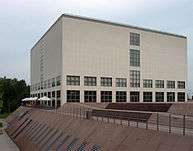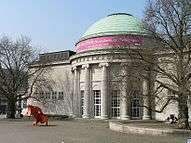Kunsthalle Hamburg
 | |
| Established | 20 August 1869 |
|---|---|
| Location |
Glockengießerwall 20095 Hamburg, Germany |
| Coordinates | 53°33′18″N 10°00′10″E / 53.55500°N 10.00278°ECoordinates: 53°33′18″N 10°00′10″E / 53.55500°N 10.00278°E |
| Type | art museum |
| Visitors | 382,000 (2013)[1] |
| Director | Hubertus Gaßner |
| Owner | Free and Hanseatic City of Hamburg |
| Public transit access |
|
| Website |
hamburger-kunsthalle |
The Hamburg Kunsthalle is the art museum of the Free and Hanseatic City of Hamburg, Germany. It is one of the largest museums in the country.
The name 'Kunsthalle' indicates the museum's history as an 'art hall' when founded in 1850. Today, the Kunsthalle houses one of Germany's few art collections, allowing a tour through seven centuries of European art, from the Middle Ages to the present day. The Kunsthalle's permanent collections focus on North German painting of the 14th century, paintings by Dutch, Flemish and Italian artists of the 16th and 17th centuries, French and German drawings and paintings of the 19th century, and international modern and contemporary art.
The Kunsthalle consists of three connected buildings, dating from 1869, 1921 and 1997, located in the Altstadt district, between the Hauptbahnhof (central station) and the two Alster lakes.
History
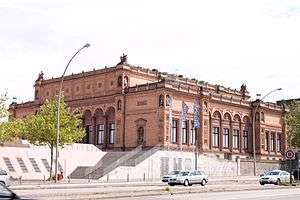
The Kunsthalle has its origins in 1849, when established and opened a year later as 'Städtische Gallerie' (municipal painting gallery) by the Hamburg Kunstverein, which was founded in 1817. The collection grew quickly, and it soon became necessary to provide a building. The original red brick Kunsthalle was built from 1863 to 1869, designed by architects Georg Theodor Schirrmacher and Hermann von der Hude, and financed largely through private donations. The first director became the art historian and educator Alfred Lichtwark (1852–1914). His successor during the interwar period was Gustav Pauli, who also oversaw the completion of the Kuppelsaal (domed-hall) extension, the Kunsthalle's first annex, designed by Fritz Schumacher and erected between 1914 and 1921.
In 1994, one painting of the Kunsthalle was involved in the so-called Frankfurt art theft. While on loan to the Kunsthalle Schirn in Frankfurt, the painting Nebelschwaden by Caspar David Friedrich was stolen. After negotiations with the thieves, a lawyer bought back the painting; when the Kunsthalle refused to pay him the agreed "consideration", he sued and won. In 1997, the Kunsthalle received, the 'Galerie der Gegenwart', a 5,600 square metres (60,000 sq ft) extension, designed by Cologne architect Oswald Mathias Ungers and dedicated to the Kunsthalle's contemporary art collections. The cubic building sits on a monolithic base at a prominent location in close proximity to the Binnenalster.
Since 2014, the Kunsthalle is under a euro 22 million renovation, in which the old main entrance is being re-activated as sole entrance for the entire complex, planned to be reopened in April 2016.[2]
Collections
The Kunsthalle is divided into four different sections: the Gallery of Old Masters, the Gallery of 19th-century Art, the Gallery of Classical Modernism and the Gallery of Contemporary Art.
The highlights of the collection include the medieval alters of Master Bertram and Master Francke, 17th-century Dutch paintings, works of early to mid 19th century German Romanticism, and collections of impressionism and classic modernism. The Kunsthalle Museum is also known for its international contemporary art collections and exhibitions, which include post-1950 Pop Art, conceptual art, video art and photography.
Old Masters
The Old Masters Collection shows works by Bartel Beham, Bernardo Bellotto, Lucas Cranach the Younger, Master Francke, Francisco José de Goya y Lucientes, Johann Georg Hinz, Jan Massys, Giambattista Pittoni, Rembrandt Harmensz van Rijn, Peter Paul Rubens, Jacob Isaacksz van Ruisdael and Giovanni Battista Tiepolo, among others.

19th-century Art
The Gallery of 19th-century art shows work by Carl Blechen, Arnold Böcklin, Gustave Courbet, Edgar Degas, Anselm Feuerbach, Caspar David Friedrich, Jean-Léon Gerome, Wilhelm Leibl, Max Liebermann, Édouard Manet, Adolph Menzel, Claude Monet, Auguste Rodin and Philipp Otto Runge, among others.

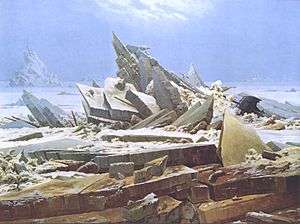 C. D. Friedrich:
C. D. Friedrich:
The Sea of Ice (1824) Max Liebermann:
Max Liebermann:
Jacob Restaurant (1902)_-_01.jpg)
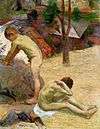 Paul Gauguin:
Paul Gauguin:
Breton Boys Bathing (1888)
Modern Art
The Classical Modernism gallery shown works by Francis Bacon, Max Beckmann, Lovis Corinth, James Ensor, Max Ernst, Ernst Ludwig Kirchner, Paul Klee, Oskar Kokoschka, Paula Modersohn-Becker, Edvard Munch, Emil Nolde and Pablo Picasso, among others.
_-_Hamburger_Kunsthalle.jpg)
 Franz Marc:
Franz Marc:
Elephant (1907) Ernst Ludwig Kirchner:
Ernst Ludwig Kirchner:
Self-portrait with model (1910) Paul Klee:
Paul Klee:
Revolution of the Viaduct (1937)
Contemporary Art
The Gallery of contemporary art shows works by Joseph Beuys, Tracey Emin, David Hockney, Rebecca Horn, Ilya Kabakov, On Kawara, Yves Klein, Kitty Kraus, Robert Morris, Hermann Nitsch, George Segal, Richard Serra, Franz Erhard Walther and Andy Warhol, among others.
Temporary exhibitions

The Hamburg Kunsthalle continuisly carries out temporary exhibitions on contemporary and historic art, in addition to its constant rotation of temporary exhibitions. Yearly there are on average 20 special exhibitions.
Past temporary exhibitions
- 2010–2011: Cosmos Runge. The Dawn of Romanticism
- 2011–2012: Max Liebermann. Pioneer of Modern Art
- 2012–2013: Giacometti. The Playing Fields
- 2013–2014: Serial Attitudes, Repetition as an artistic method since the 1960s
- 2013–2014: Alfred Flechtheim.com, Art Dealer of the Avant-Garde
- 2014–2015: ars viva Prize for Fine Arts
- 2014–2015: Max Beckmann. The Still Lifes
- 2014–2015: Feuerbach’s Muses — Lagerfeld’s Models
Current and upcoming temporary exhibitions (2015–)
- 2014–2016: SPOT ON, Masterpieces from the Hamburger Kunsthalle
- 2015–2016: Nolde in Hamburg
See also
References
- ↑ "Rekordbilanz: Mehr als 382.000 Besucher in der Kunsthalle (10.01.2014)". abendblatt.de (in German). Hamburger Abendblatt, Hamburg. Retrieved 7 May 2015.
- ↑ "Modernisation". weiter-offen.de. Hamburger Kunsthalle. Retrieved 7 May 2015.
External links
| Wikimedia Commons has media related to Hamburger Kunsthalle. |
- Hamburger Kunsthalle - Official site (German) (English)
- Freunde der Kunsthalle (friends' association) (German)
- Online shop (German) (English)
- The Cube Restaurant in the Gallery of Contemporary Art of the Hamburger Kunsthalle (German) (English)
- Hamburger Kunsthalle on Hamburg Tourism (German) (English)
